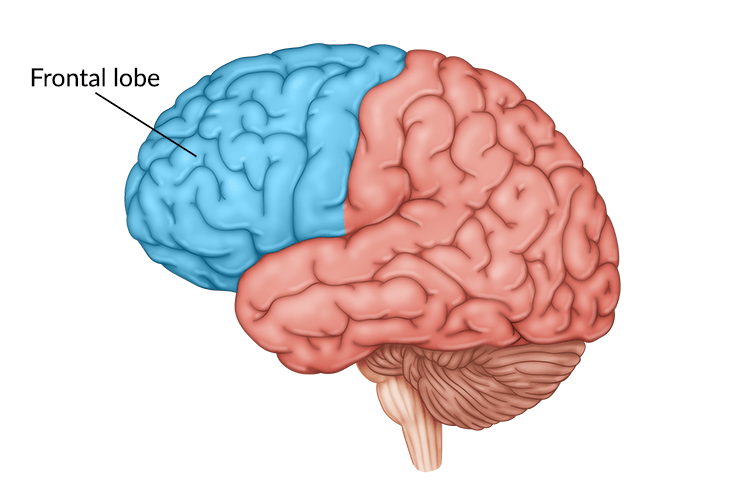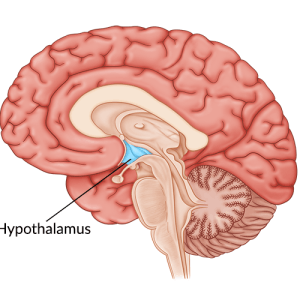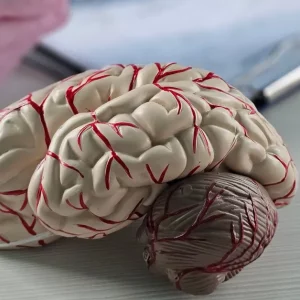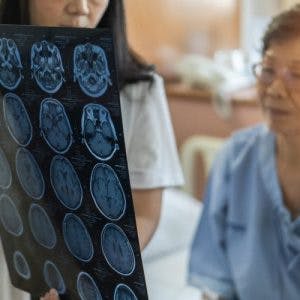As its name suggests, the frontal lobe is located in the front region of the brain, near the forehead. Damage to the frontal lobe may cause a variety of effects including impaired muscle movements, personality changes, and impulsive behavior. Fortunately, many individuals are able to recover functions affected by frontal lobe damage and improve their quality of life.
To help you understand what to expect after frontal lobe damage, this article will discuss:
Frontal Lobe Functions
When the frontal lobe becomes damaged by traumatic brain injury, it can affect functions primarily based in this area. Before diving into the effects of frontal lobe damage, let’s briefly discuss some of those functions!
To begin, the frontal lobe plays a major role in executive function, which regulates our behavior. Examples of executive function include things like memory, problem-solving, and planning. The frontal lobe also contributes to emotion regulation.
The left half of the frontal lobe is home to Broca’s area, which is one of the language centers of the brain. Broca’s area helps put thoughts into words and form complete sentences. It is one of several areas of the brain that contribute to language.
The primary motor cortex also resides within the frontal lobe. This area of the brain generates neural impulses that control muscle movement. This allows a person to perform physical activities like walking and holding a pencil.
In the next section, you will see how these functions can change after the frontal lobe sustains damage from a traumatic brain injury.
Frontal Lobe Damage Symptoms
The symptoms of frontal lobe damage can vary from person to person. That’s because every brain injury is different, and therefore every survivor may experience different effects. Furthermore, the frontal lobe encompasses a large portion of the brain. As a result, there is a wide variety of potential secondary effects that a brain injury survivor may experience.
Let’s take a look at some of the secondary effects and individual with damage to the frontal lobe may experience.
Frontal Lobe Damage Effects
- Aphasia: An umbrella term for different types of language and communication disorders.
- Loss of voluntary movement: This can include difficulties with gross motor skills and fine motor skills.
- Short-term memory loss: Frontal lobe damage can make it difficult to store memories for a short period of time.
- Poor planning skills: Individuals may struggle with accomplishing projects that involve various steps. Even if they know how to accomplish each individual step, they may struggle with doing them in the right order.
- Lack of empathy: Difficulties with seeing things from another person’s perspective can lead to lack of empathy or self-centeredness.
- Impulsivity: Individuals may act without thinking about potential consequences.
- Left hemispatial neglect: This causes difficulty noticing visual stimuli on the left side, if only the right frontal lobe has been affected. Right hemispatial neglect, although less common, may also occur if only the left portion of the frontal lobe is affected.
- Personality changes: Since the frontal lobe contributes to emotion and behavior, personality changes can occur after damage.
- Anosognosia: This condition refers to a lack of insight that impairs an individual’s awareness of their change in abilities.
- Lack of motivation: An individual with frontal lobe damage may struggle with feeling motivated. This can be a stand-alone secondary effect or it can stem from other secondary effects like anosognosia.
- Poor attention: Individuals may struggle with poor attention span and are easily distracted.
- Disorganized thinking and behavior: These executive functions can become challenging after frontal lobe damage.
- Confabulation: This condition causes a person to create false memories.
- Disinhibition: Refers to loss of control over behavior and emotions.
- Perseveration: This involves continuous repetition of actions, words, or thoughts.
Additional Secondary Effects of Frontal Lobe Damage
When an individual experiences a traumatic brain injury, one or both hemispheres may become damaged. In other words, even if the trauma made impact on the left side, the right side can sustain damage as the brain rebounds from the initial impact. This is known as a coup-contrecoup injury.
Many of the secondary effects of frontal lobe damage depend upon which hemisphere sustained damage. For example, left neglect occurs when the right frontal lobe sustains damage; and language difficulties usually occur if the left frontal lobe sustains damage.
However, it is important to remember that every brain injury is unique, which means every person can experience different secondary effects and recovery outcomes.
Can Frontal Lobe Damage Repair Itself?

Many regions of the brain work together to carry out a variety of functions. As a result, many of the effects of frontal lobe damage can be recovered by utilizing neuroplasticity.
Neuroplasticity is the brain’s ability to reorganize itself based on the behaviors we repetitively perform. As a result, it’s possible for functions affected by frontal lobe damage to be rewired to unaffected regions of the brain and improved.
The most effective way to promote neuroplasticity is to stimulate the brain through repetitive practice of affected functions. For example, an individual with aphasia may promote neuroplasticity by practicing language-related exercises to help encourage the brain to improve the function of language. The brain likes to be efficient and understands when there is demand for a function and adapts to make that function occur more easily.
Individuals can learn effective ways to stimulate the brain by participating in rehabilitative therapies that target the effects of their specific frontal lobe brain injury. This will allow frontal lobe brain injury survivors to promote neuroplasticity and regain as much function as possible.
Frontal Lobe Damage Treatment
Treatment for frontal lobe damage focuses on identifying the functions that have been affected by the brain injury and practicing those functions.
It’s important to know, however, that frontal lobe damage can affect an individual’s motivation and ability to participate in goal-directed behaviors such as rehabilitation. Additionally, they may not believe that they have any functional deficits from their brain injury to be working on (anosognosia). When this occurs, it can be challenging for frontal lobe brain injury survivors to participate in a rehabilitation program.
For this reason, cognitive rehabilitation and Cognitive Behavioral Therapy may need to be prioritized so that the individual can find long-term motivation to pursue other therapies. We will discuss these first.
Want 20 pages of brain injury recovery tips in PDF form? Click here to download our free ebook “15 Things Every TBI Survivor Must Know” (link opens a pop up for uninterrupted reading)
Cognitive Rehabilitation
Cognitive rehabilitation involves practicing cognitive skills such as memory, critical thinking, and problem-solving. When individuals practice these functions, it helps rewire the brain and improve cognitive skills.
Occupational therapists (OTs) and Speech-Language Pathologists (SLPs) are great resources for this type of rehabilitation. They understand how to identify problem areas and target those functions with specific exercises.
Applications that can be used from home such as the CT Speech & Cognitive Therapy App, can offer additional speech and cognitive training exercises outside your regular sessions with an SLP and/or OT. This can be a great way to get extra repetitions in and promote recovery.
Cognitive-Behavioral Therapy
Cognitive-behavioral therapy is a type of psychotherapy that helps individuals better understand their negative thoughts and behaviors and suggests more effective ways of coping with them. This can be especially helpful for frontal lobe brain injury survivors who struggle with personality changes, social interactions, and other cognitive deficits.
Physical Therapy
After frontal lobe damage, individuals may experience weakness (hemiparesis) or paralysis (hemiplegia) on one side of their body. Generally, this loss of voluntary motor control in the body is caused by damage to the motor cortex on the opposite side of the brain. For example, damage to the left side of the frontal lobe may affect movements on the right side of the body. This may affect balance and walking ability.
Physical therapy can help individuals address hemiparesis or hemiplegia through the practice of targeted exercises. Physical therapists will encourage individuals with frontal lobe damage to continuously practice using their affected side to promote neuroplasticity and strengthen those functions.
Want 25 pages of TBI recovery exercises in PDF form? Click here to download our free TBI Rehab Exercise ebook now (link opens a pop up for uninterrupted reading)
Occupational Therapy
Occupational therapy focuses on helping individuals become as functional as possible. Especially if you experience weakness or paralysis after frontal lobe damage, it may be difficult to perform everyday activities and care for yourself.
An occupational therapist will help you practice self-care tasks, such as getting dressed, or teach you compensatory tactics to make up for limited motor control or executive functioning skills. They may also focus on increasing your independence with more challenging tasks, such as preparing a meal or returning to work. Additionally, an occupational therapist can help suggest tips to help you go about your everyday life such as setting reminders on your phone, following a routine, using adaptive equipment, and becoming familiar with potential complications that may arise as a result of your brain injury.
Speech Therapy
Speech therapy can help individuals who experience language difficulties or cognitive deficits after frontal lobe injury. As mentioned earlier in this article, damage to the left hemisphere can result in aphasia, which affects an individual’s ability to produce and/or understand language.
Speech therapy can teach individuals with aphasia how to develop their vocabulary and speak in coherent sentences. Additionally, a speech therapist can help individuals with cognitive deficits such as memory problems, attention deficits, or poor planning skills practice activities to improve these functions. Furthermore, if eating and swallowing functions have been affected, speech therapists are able to address these as well.
Treating the effects of frontal lobe damage can be challenging and take time, but with consistent practice, it is possible. The following section will address what to expect when living with someone with frontal lobe damage.
Living with Someone with Frontal Lobe Damage
Ambiguous loss refers to a loss that occurs without closure or any of the typical markers that accompany grief. The term was coined by psychologist Pauline Boss who described it as a “physical presence but psychological absence” such as in cases of dementia or Alzheimer’s disease. It also frequently accompanies traumatic brain injury, especially with frontal lobe damage.
Because frontal lobe damage often results in personality changes, the people closest to the injured person may feel like they have lost their loved one, when in fact they have just changed. Therefore, living with someone with a frontal lobe brain injury can lead to a complex blend of grief and guilt; grief for the loss of the person they once knew, and guilt for feeling that way when that person is still alive.
Ambiguous loss can also affect the person with the injury, especially when they have accepted or adapted to their new way of life.
Unresolved ambiguous grief leads to emotional problems and makes it difficult to move forward with recovery. Resolving the feelings associated with ambiguous loss is an important step that allows both you and your loved ones to finally move forward.
Frontal Lobe Brain Injuries: Key Points
A frontal lobe brain injury can cause changes in behavior, thinking, and movement. Fortunately, the brain is capable of rewiring itself, which means there is always potential for recovery.
While individuals may experience difficulties setting goals and acting on them after frontal lobe damage, trusting in your rehabilitation team and participating in therapeutic exercises can help promote adaptive changes in the brain and strengthen affected functions. Gradually, improvements may occur.
We hope this article helped you understand the potential outcomes of frontal lobe damage and how to promote recovery.










